Amped Wireless R20000G, SR20000G, and UA2000: Routers, Repeaters, and Adapters (Oh My!)
by Jarred Walton on June 23, 2012 12:00 AM EST- Posted in
- wireless
- Networking
- 802.11n
- Amped Wireless
Test Location C Results: Worst-Case Performance
Our third and final test location is at a relatively extreme testing distance of 60 feet, with several walls plus a metal garage door in between the adapters and the routers. If Location B was Nightmare difficulty in Diablo III, we’re now firmly into the Hell difficulty. Anecdotally, I can also state that at this particular location, many wireless devices (e.g. my iPod Touch 4th-gen and a couple different tablets) also have serious problems connecting/maintaining a connection with my Netgear router—once I’m in my car and start leaving the driveway, WiFi gets dropped and I have to go back inside if I want to get a quick set of directions before heading out.
As far as testing this location goes, while I did manage to achieve connections with all three adapters and routers—even with the 5GHz signal—in practice the throughput was quite variable and very low. Day-to-day variance in testing was also even more pronounced this time; at one point I got nearly twice the throughput on one router+adapter combination, but I wasn’t able to repeat that performance so I discarded the earlier results. I also dropped the NTttcp testing for this location; my test script transfers 1.5GB of data, and while that only takes 2-5 minutes at the first test location and twice that at Location B, for this test location I could be looking at 20 minutes or more for some of the test cases this time. Run that five times over 26 router/adapter combinations and—assuming everything even worked out properly—I’d be looking at two solid days sitting out in my driveway. The file copy tests thankfully only use 203MiB and generally correlated well with the NTttcp results, so I’ve just used those tests.
Keep in mind that Amped also claims up to 10000 square feet of coverage for the R20000G; at 60 feet, we’re actually slightly beyond that point, so the question is more whether you think 60 feet from your router is really all that impressive. Personally, I’d be more than a little disappointed if my wireless network couldn’t reach at least 60 feet and through a couple walls. Out in the open, I’d think a couple hundred feet (e.g. in a parking lot) would be easy enough for most decent wireless routers. Anyway, let’s see what happens at our “extreme” range.
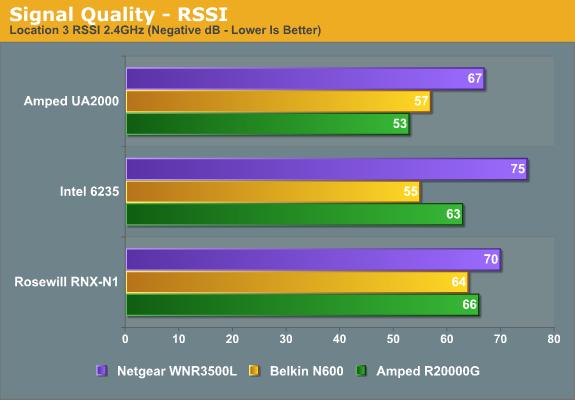
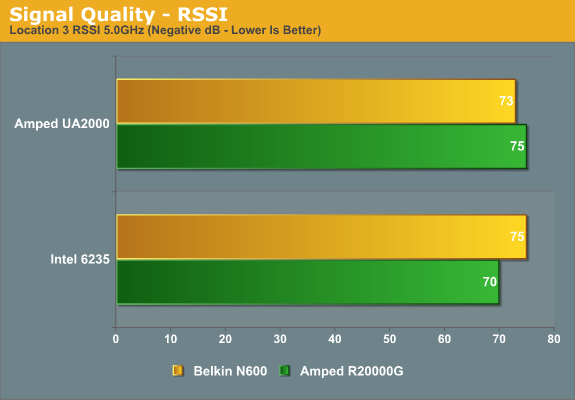
RSSI is now starting to get into the range where connections get flaky, particularly with the 5GHz spectrum. -70dB or higher (e.g. -60dB) is usually sufficient for getting and maintaining a connection, but beyond that I typically see some drops and need to reconnect. Amped advertises the R20000G as a superior “long distance” router, but while the RSSI values are better than those of the Netgear, the Belkin N600 actually claims several wins this time. It’s possible that if the Belkin router is tuned more for distance than throughput, it might actually surpass the Amped router this time.
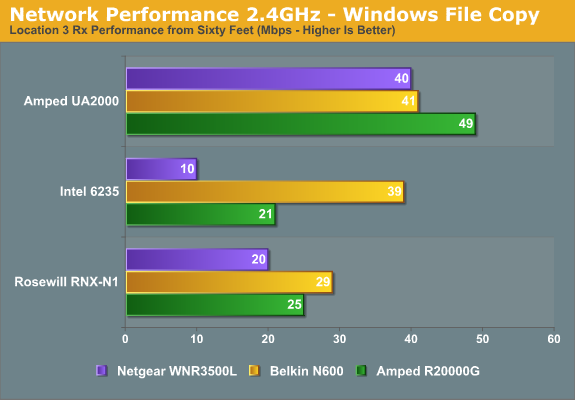
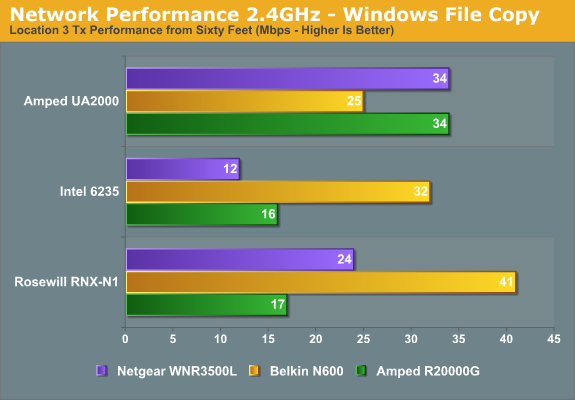
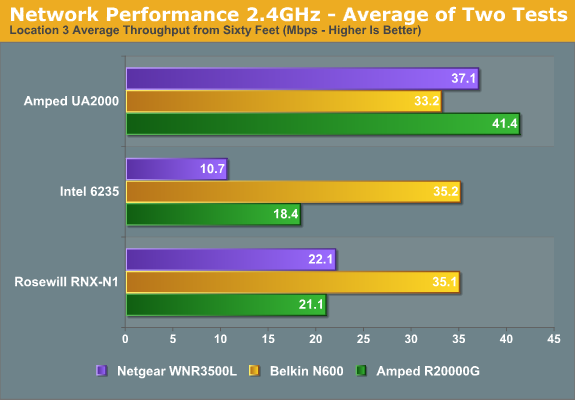
Given that testing was done over the course of several days with different weather patterns, I’m not sure just how much detail we can draw from the above charts. The UA2000 adapter generally beats the other two adapters, but it’s possible some of the results are simply “luck of the draw”. In terms of routers, the Belkin N600 comes out on top this time, delivering relatively constant performance with all three adapters—it ends up nearly 50% faster than the Netgear router and just over 25% faster than the Amped R20000G. Meanwhile, for average performance the UA2000 is about 75% faster than the Intel 6235 and 45% faster than the Rosewill RNX-N1. I was actually hoping for even more at this location, considering Amped advertises 600mW transmit power on the UA2000, but a 50% or more improvement is hardly something to scoff at.

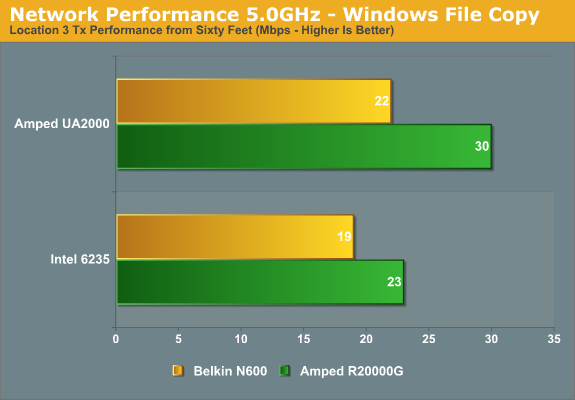
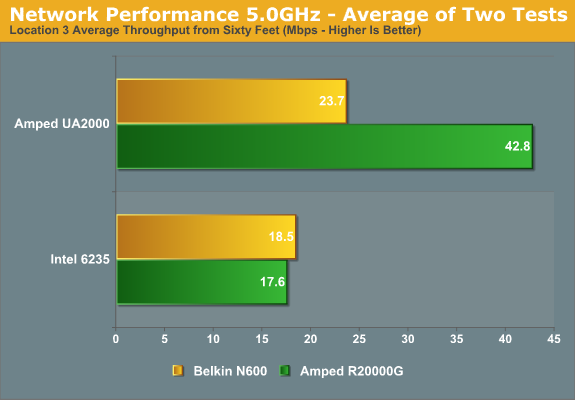
With 5GHz, the Amped + Amped combination delivers some awesome results, but again I have to question if these are reliable results or not given the variability—there were certainly times where the UA2000 managed far less than 20Mbps for example. As it stands, the UA2000 directional adapter is on average 84% faster than the Intel 6235 omnidirectional adapter—and that makes sense as signal strength drops off rapidly as we move away from the source. The R20000G also comes out on top, though that’s largely thanks to the stellar result with the UA2000; it ends up being 43% faster than the Belkin N600, but it’s really a case of nearly equal performance with the Intel 6235 (with the Belkin actually having a small 5% lead) and a massive 81% gulf with the UA2000.
If I had been wise, I would have tabulated all the individual results and come up with a throughput distribution graph (similar to what Brian does with our smartphone Speedtest results), but unfortunately I only considered doing that after the fact. It would also become rather difficult to compare results between routers and adapters using such charts. Still, if there’s enough desire for such testing, I can revisit the subject with a smaller article. Either leave a comment or drop me an email if you’re interested in such testing.










28 Comments
View All Comments
tonyt87 - Saturday, June 23, 2012 - link
Cisco/Linksys switched to Marvell chipsets with the 4200v2 and 4500, the original 4200 uses Broadcom.arthur449 - Saturday, June 23, 2012 - link
I used the SR10000 repeater recently to provide a solution for weak / non-existent signal anywhere beyond the far end of their apartment where they kept all of their computer equipment. I positioned the repeater in a higher/more centralized location and they get great reception to it.This is after I made absolutely sure they could not stand to run an ethernet cable/use powerline networking or reposition their overpriced fruit-branded wireless router to a new (higher) location rather than keeping it beneath a desk. Apparently, they have a fear of wires, yet hate unreliable connections. *shrug*
Anyhow, the repeater gives them reception in the places where it was simply impossible and didn't create any additional unsightly cords.
I've only run into one problem: When the fruit-branded wireless router loses power, the SR10000 repeater freaks the *$(@ out and does not automatically reconnect to the fruit-branded network when it comes back online. While I'm certain a static IP for the wireless repeater would fix this, the client can't remember the fruit-branded router's admin password and a full reset is strictly forbidden.
ShinyLeaf - Saturday, June 23, 2012 - link
I have this same repeater (SR10000) and a non-fruit branded router with the same problem. I tried to switching to static IP and it doesn't fix the problem.Anytime the router / access point loses power, or the repeater loses the wireless connection for a sec (microwave interference, etc), the repeater just craps out and I need to unplug/plug-in to get it to reconnect.
Probably a firmware issue, but there hasn't been any update in 6 months.
irev210 - Saturday, June 23, 2012 - link
There is a bigger comparison over at smallnetbuilder - not really that impressive:http://www.smallnetbuilder.com/wireless/wireless-r...
Pretty sad, really.
mevans336 - Saturday, June 23, 2012 - link
I read the Smallnetbuilder review and came away with the same opinion.Their "coverage" claims reek of sleazy marketing hype to confuse the average consumer. "Oh look, we cover 10,000 bajillion feet!" when in actuality, their coverage is no better than any other wireless router on the market.
JarredWalton - Saturday, June 23, 2012 - link
Note that the smallnetbuilder review is for the R10000G, so there's no 5GHz support. Looks like 2.4GHz support is roughly the same, given our different test locations, though I was able to connect at the worst-case location without trouble. Also note that smallnetbuilder only tests with one wireless adapter on the newer routers, the Intel Ultimate-N 6300. If you couldn't tell, in my experience the choice of wireless adapter can make a very large difference in some tests.That's the hard thing with wireless testing: change any variable (router, adapter, time of day, weather, drivers, test laptop, positioning, etc.) and you can't guarantee the results are directly comparable. Ideally, I'd want to do a large roundup of at least ten different wireless adapters and test those with a couple different routers -- and if you really want to be apples-to-apples, you'd need to test them all in the same laptop or use a PCI card. From that, you can determine which adapters work best in general. Then take the top three adapters and test every router with those adapters, and you should be able to determine which routers work the best.
That, incidentally, is a TON of work, assuming you can even get all the hardware to test with. Given the amount of testing, you'd be looking at different adapters/routers on different days with different weather, so you'd probably need to test each adapter/router combination at least twice (e.g. several days apart) to verify there's no massive change in performance, and if there is then test a third time. I'm not sure if there's enough value in doing that much testing, so the result is more "rough estimate" type reviews, like what I've done.
Olaf van der Spek - Saturday, June 23, 2012 - link
Isn't DD-WRT (development) dead anyway?JarredWalton - Saturday, June 23, 2012 - link
I don't believe so; you can get a build dated March 15, 2012 for the ASUS RT-N66U for example. There are also similar tools out there (OpenWRT, MyOpenRouter--Netgear only on that one). I think it would be best to state that the set of new hardware being supported is very limited, so if you want DD-WRT support you need to shop with that intention.Olaf van der Spek - Sunday, June 24, 2012 - link
Latest stable release has been v24 SP1 (Build10020) and Latest development release has been v24 preSP2 (Build13064) for years.A build dated March 15, 2012 doesn't mean that much.
Is there a comparison between DD-WRT and OpenWRT available somewhere?
blindbox - Monday, June 25, 2012 - link
You should take a look at their source revisions. For example, OpenWrt just hit their 32000th revision about a month ago.Anyway, here's where you can see progress.
OpenWRT https://dev.openwrt.org/browser
DD-WRT http://svn.dd-wrt.com/browser
Last commit for OpenWRT was 20 hours ago. For DD-Wrt, it was 50 minutes ago.
DD-WRT does provide snapshot builds but I don't know why they've stopped releasing stable builds altogether. OpenWrt at least has their somewhat yearly stable releases.